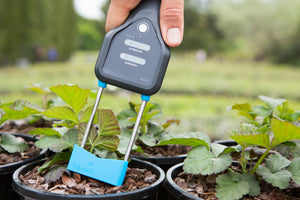How Garden Design & Climate Control Can Help Prevent Powdery Mildew
So the background check into powdery mildew spores confirms that they can be a habitual offender, a persistent pain. If your plants have ever been afflicted, then you know PM is a menace. What makes PM a phantom menace? Standard definitions of ‘phantom’ suggest something unreal, like a ghost. That obviously doesn’t apply here. Ask any gardener who has dealt with PM: it’s all too real. Ask that same person how they feel about PM and they may well touch on other definitions of phantom: something hated, feared, or deceptive.
What’s the Deal with That Fungi?
One tricky aspect of spores in the garden is that they’re opportunistic. They hang out undetected until the right conditions arise and then, basically, it’s too late. If you find powdery mildew on your plants, it’s likely been there a while and there are already thousands of spores doing their thing—reproducing.
Finding PM at any stage of growth is disheartening. An insidious twist is that as your garden grows, it can create conditions that increasingly favor fungi. As plants grow bigger, they may get crowded—reducing airflow. As plants mature, their increased water consumption and transpiration can raise humidity levels into the danger zone. You could be midway through a crop that otherwise looks great, then, next thing you know, you’re facing a fungal battle.
Gardens and gardeners in Colorado are blessed; the semi-arid climate can work in your favor when facing powdery mildew. However, it may also contribute to complacency and lazy gardening habits. It’s easy to assume that since you grow in a relatively dry region, fungi won’t flourish. This is an especially easy mistake to make if you’ve never had PM.
Prevention and Mitigation
As noted in the first blog post on PM, prevention is key. The following are some ways to fend off this garden enemy so that you and your plants don’t end up having to fight it.
Garden management of pests and diseases is, generally speaking, viewed in terms of cultural, biological, and chemical controls. Let’s take a look at cultural controls for powdery mildew.
Cultural Controls
Cultural controls are the first line of defense against pests or diseases. They include many gardening basics and can seem so sensical that they get overlooked or forgotten. When used successfully, they spare you the hassles, costs, and dangers associated with some of the treatment options.
Let’s begin with a breakdown of garden design and climate control. Exposure to the outdoors should be minimized by sealing cracks, holes, gaps, etc. If your garden employs air exchange, make sure your intake/exhaust fans are able to move enough air through your space to do a full air exchange once every 2-5 minutes. Intake air should be filtered and any intake ducting should be insulated in order to keep condensation from forming. If you choose a sealed garden, a dehumidifier (or multiple dehumidifiers) and an air conditioner become crucial to your grow. You’ll likely also need a heater.
Climate Control
Climate control is the heart of your grow operation. So far, you have come to understand that it is important to address the steps to exclude spores from your grow. Which, due to the nature of fungi and spores, can be difficult. You will have to come to terms with the presence of some spores is inevitable: climate control is the single best way to avoid their fungal takeover. As a grower, you’ve probably heard it a million times but it still bears repeating: strive to maintain a stable climate.
Humidity
Avoid extreme fluctuations in temperature and humidity- like those that are prone to happen as your lights cycle on/off. Monitor your humidity like a hawk (especially at night) and do what it takes to avoid prolonged periods of elevated humidity. In the latter phase of plant growth, humidity should never, stay over 45-50% for too long. Many growers keep their garden drier than that to be on the safe side, which may require a larger dehumidifier or bigger intake/exhaust fans.
Air Circulation
So, you’ve got enough ventilation, how about circulation? Make sure you’ve got enough strategically placed oscillating fans to avoid stagnant climate pockets which can become breeding grounds for spores. Keeping your garden’s relative humidity under control and providing adequate airflow are your best allies in the war on spores.
Chasing Every Summer
As an indoor gardener, you likely already understand how important climate control is: it’s what allows you to garden year-round. It’s like creating or manipulating the weather in order to have one perpetual perfect season, and it’s not easy. Climate control is at the heart of your indoor garden’s health, not just for preventing fungal problems. With so much at stake and so many variables involved, the expense of an environmental controller becomes increasingly appealing and may be justified depending on your gardening goals.
Creating an indoor garden presents many challenges and requires plenty of time and effort to get things right. Prioritizing climate control saves time, money, and labor in the long run. It allows you to prevent problems from the get-go, instead of treating them as they arise.
Keep a lookout for our continuing blog series on cultural controls and gardening techniques that keep the phantom menace out of your garden. To read more, visit our blog page or visit one of our seven stores and our knowledgeable staff.
